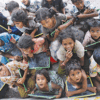Uttarakhand: Judicial offensive
 The Uttarakhand high court has passed strictures against the state government for the pitiable condition of its public schools. Admitting a public interest litigation (PIL) writ petition (No. 201 of 2014, Deepak Rana vs. State of Uttarakhand & Ors), the court directed the government to initiate action and report to it within three months. “The facilities provided in the schools are primitive and not conducive to the health of students… It is a pity that even after more than 68 years of independence we are making the children sit on mats in winter as well as summer,” observed a two-judge bench in the order passed on November 19.
The Uttarakhand high court has passed strictures against the state government for the pitiable condition of its public schools. Admitting a public interest litigation (PIL) writ petition (No. 201 of 2014, Deepak Rana vs. State of Uttarakhand & Ors), the court directed the government to initiate action and report to it within three months. “The facilities provided in the schools are primitive and not conducive to the health of students… It is a pity that even after more than 68 years of independence we are making the children sit on mats in winter as well as summer,” observed a two-judge bench in the order passed on November 19.
Even though Uttarakhand (pop.10 million) hosts some of the country’s top-ranked private schools (Welham Boys, Welham Girls, The Doon School), its 12,533 primary, 2,809 upper primary and 2,203 secondary government schools, and its aided 184 upper primary and 301 secondary schools administered by the Uttarakhand Education Board, are a shambles.
Taking judicial notice of this ground reality, the court issued specific directives to the state government to equip government schools with benches, desks, blackboards, computers, well-stocked libraries and laboratories, as well as separate usable toilets for boys and girls. It warned that principals will be held personally responsible for ensuring government and aided school students are also provided mid-day meals, well-lit and ventilated buildings, water purifiers, heaters for winter months and ceiling fans for summer.
Evidently, the court’s (Justices Rajiv Sharma and Alok Singh) stern directive to Uttarakhand’s (Congress) government is influenced by several authoritative reports highlighting the pathetic condition of the state’s public education system. A recent (May 2016) report, ‘Prospects, Challenges and Achievements of Right to Education in Uttarakhand’ published in the Research Journal of Educational Sciences, ascribed the continuous flight of children from government to private schools “to…. lack of basic facilities like toilets, electricity, playground, libraries, furniture and even school buildings”.
Despite this dismal public education scenario, on several parameters Uttarakhand is ahead of most of India’s 29 states if not the seven Union territories. According to the Annual Status of Education Report (ASER) — an annual survey conducted by the Mumbai-based NGO Pratham to assess children’s literacy and maths learning outcomes countrywide– a mere 1.5 percent of Uttarakhand’s children in the 6-14 age group are out of school. Moreover, 60 percent of the state’s class V children can read and comprehend class II texts cf. the national average of 48.1 percent.
Comments Jaya Mishra, a member of Uttarakhand’s State Commission for Protection of Child Rights: “The state’s children face daunting challenges even getting to school. In times of natural calamities, schools are the worst hit. It is unfair that children should be denied basic facilities. The high court’s verdict will provide much needed relief to the state’s children, and is very welcome.”
Yet it’s pertinent to bear in mind that the implementation authority of the court’s order is Uttarakhand’s notoriously corrupt and inept education ministry.
Puja Awasthi (Dehradun)
















Add comment